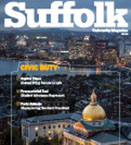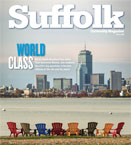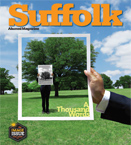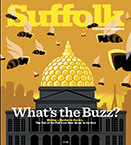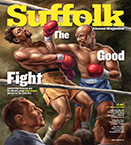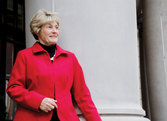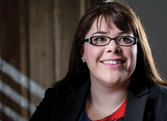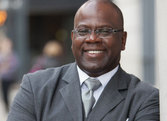The Big Picture
It’s a bright May morning at the Blue Hills Bank Pavilion along the Boston waterfront, and Joseph Hooley, chairman, president, and CEO of one of the world’s leading providers of financial services, delivers this message to 736 graduating Sawyer Business School students: “Put down your devices. Tune out now and then.”
That afternoon at the same venue, Kate Walsh, president and CEO of the largest safety-net hospital in New England, tells 851 graduating College of Arts & Sciences students, “Life is not on your phone screen. . . please look up, look around, appreciate the world around you.”
When the leaders of a Fortune 500 financial company like State Street Corporation and a nonprofit teaching hospital such as Boston Medical Center independently share the same advice, it is likely part of a larger conversation. Sure enough, the same month, a series on NPR’s All Things Considered suggested that “technology is taking us away from our memories.” Kainaz Amaria, a photographer on NPR’s visual team, said “We are overwhelmed and consume so many digital images,” but she also believes that “actually taking the time to print them out is going to solidify that memory.” And, she suggests, taking pictures makes us more engaged in the world: “[w]hen we’re making images as photographers . . . we’re living that moment. It’s not passive.”
In an age when a means of preserving the past has also become a way to live in the present, the adage that “A picture is worth a thousand words” takes on added currency.It also inspired this special edition of Suffolk Alumni Magazine (SAM), which begins with three accomplished photographers who are Suffolk graduates.
Tokyo native Keiko Hiromi BA ’04 developed her interest in photography as a student at Suffolk, and her local ties remain strong. The Massachusetts Cultural Council awarded her a 2013 artist fellowship, citing her entry’s “compelling images and exemplary use of color and framing.” Jason Landry, the owner of Boston’s Panopticon Gallery, which represents Hiromi’s work, says, “Whether she is photographing her friends and neighbors or a remote village in Liberia, Keiko Hiromi looks to capture the essence of life. I truly believe that she leaves behind a spark of positive energy in her wake.”
Our Image Issue arrives amidst a wider dialogue about the role of photography in a digital age. “The reason we wanted to have this conversation . . . is that you can enjoy the ephemeral nature of our age BUT you can curate what you want to hold on to,” NPR’s Amaria told SAM. “When I’m behind the camera, I’m actively thinking about what I want to capture. I’m composing, editing, moving, and most importantly, I’m present in the moment.”
